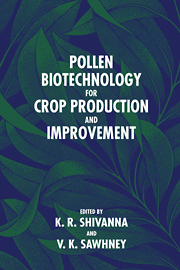Book contents
- Frontmatter
- Contents
- Contributors
- Foreword
- Preface
- 1 Pollen biology and pollen biotechnology: an introduction
- Part I Pollen biology: an overview
- Part II Pollen biotechnology and optimization of crop yield
- Part III Pollen biotechnology and hybrid seed production
- Part IV Pollen biotechnology and plant breeding
- 12 Barriers to hybridization
- 13 Methods for overcoming interspecific crossing barriers
- 14 Storage of pollen
- 15 Mentor effects in pistil-mediated pollen–pollen interactions
- 16 Pollen tube growth and pollen selection
- 17 Isolation and manipulation of sperm cells
- 18 Isolation and micromanipulation of the embryo sac and egg cell in maize
- 19 In vitro fertilization with single isolated gametes
- 20 Pollen embryos
- 21 Use of pollen in gene transfer
- Index
13 - Methods for overcoming interspecific crossing barriers
Published online by Cambridge University Press: 11 September 2009
- Frontmatter
- Contents
- Contributors
- Foreword
- Preface
- 1 Pollen biology and pollen biotechnology: an introduction
- Part I Pollen biology: an overview
- Part II Pollen biotechnology and optimization of crop yield
- Part III Pollen biotechnology and hybrid seed production
- Part IV Pollen biotechnology and plant breeding
- 12 Barriers to hybridization
- 13 Methods for overcoming interspecific crossing barriers
- 14 Storage of pollen
- 15 Mentor effects in pistil-mediated pollen–pollen interactions
- 16 Pollen tube growth and pollen selection
- 17 Isolation and manipulation of sperm cells
- 18 Isolation and micromanipulation of the embryo sac and egg cell in maize
- 19 In vitro fertilization with single isolated gametes
- 20 Pollen embryos
- 21 Use of pollen in gene transfer
- Index
Summary
Summary
Crossing barriers occur frequently when intra- or interspecific crosses are attempted. These barriers are the result of incompatibility and incongruity. Sexual barriers preventing interspecific hybridization have been distinguished into pre- and postfertilization barriers. The nature of the barrier governs the method to be used to overcome the specific barrier. A range of techniques, such as bud pollination, stump pollination, use of mentor pollen, and grafting of the style, have been applied successfully to overcome prefertilization barriers. In vitro methods in the form of ovary, ovary-slice, ovule, and embryo culture are being used to overcome postfertilization barriers that cause endosperm failure and embryo abortion. An integrated method of in vitro pollination and fertilization followed by embryo rescue has been applied in many crosses. Vital hybrid plants may display lack of flowering or male and female sterility, resulting in failure of sexual reproduction. If sterility is caused by a lack of chromosome pairing during meiosis, fertility may be restored by polyploidization, enabling pairing of homologous chromosomes in the allopolyploid hybrid. Integration of these techniques into the breeding programs would enable the breeder to introgress genes across the species barriers.
Introduction
The phenomena underlying crossing barriers are incompatibility and incongruity. Incompatibility operates in intraspecific crosses and is the result of the activity of S-alleles. Incongruity occurs in interspecific crosses as a result of lack of genetic information in one partner necessary to complete pre- and postpollination processes in the other (Hogenboom 1973). This chapter focuses on different methods used to overcome incongruity.
Interspecific and intergeneric crosses are made to introduce new genetic variation into cultivated plants.In breeding ornamental crops, interspecific hybridization is the most important source of genetic variation.
- Type
- Chapter
- Information
- Pollen Biotechnology for Crop Production and Improvement , pp. 273 - 292Publisher: Cambridge University PressPrint publication year: 1997
- 49
- Cited by

